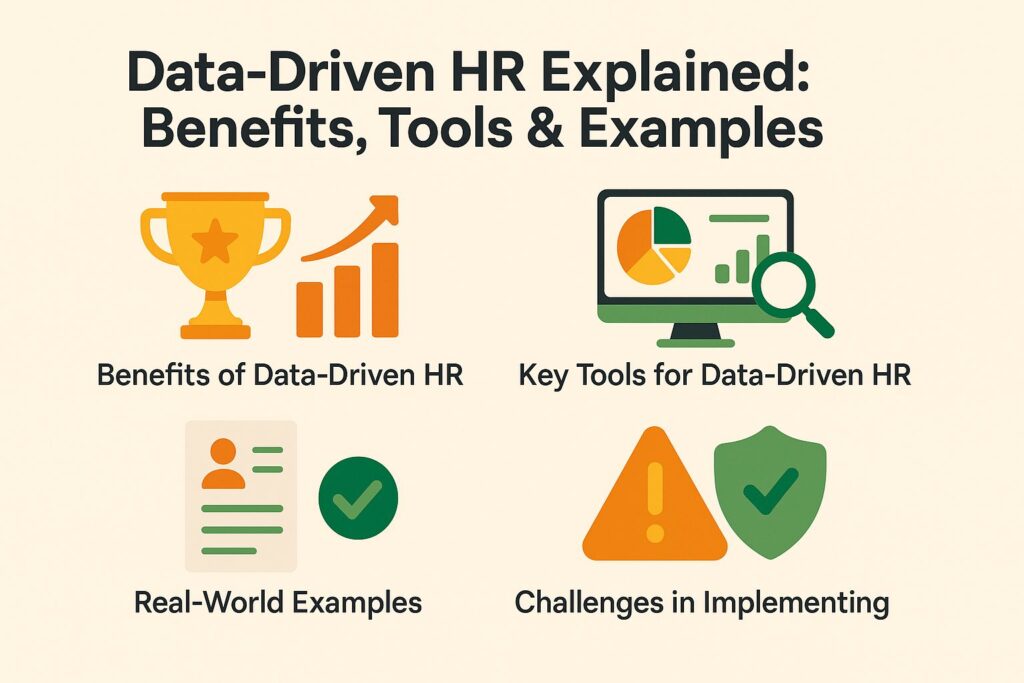
Data-Driven HR Explained: Benefits, Tools & Real-World Examples
Improve your HR practices using data-based methods and HR advice that can change your workplace. Knowing how to use data improves decision-making, increases employee involvement, and makes operations more efficient. Look at important tools that enable this and examine real-world examples showing these ideas in practice. Want to change how you handle HR? Let’s examine the advantages and difficulties of using data in HR.
Definition and Importance of Human Capital Analytics
Data-driven HR uses data analysis and business intelligence in human resources to improve decision-making and employee management.
Using tools like SAP SuccessFactors and cloud-based HR solutions, companies can examine employee performance, hiring information, and engagement levels.
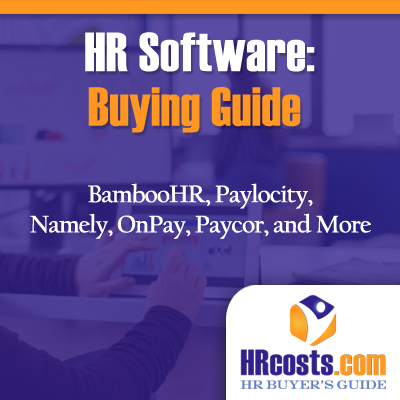
For example, HR teams can monitor turnover rates and identify trends, such as departments with higher attrition, allowing for targeted interventions. By using predictive analytics, they can predict upcoming hiring requirements by examining past data.
For an extensive analysis of this trend, our comprehensive guide to HR management examines how strategic approaches create a more agile workforce, aligning talent management and organizational culture closely with organizational goals and enhancing overall productivity.
Changes in HR Practices and Use of Technology in HR
The change in HR practices from relying on instincts to using data-based strategies is a major change in how companies handle managing their employees.
In the last twenty years, this change has been significantly aided by advanced software tools such as Workday and BambooHR. Initially, HR relied heavily on subjective assessments and personal experience.
With the advent of HR analytics tools, organizations now analyze employee performance and engagement metrics. For instance, Workday offers predictive analytics to forecast turnover rates, allowing companies to proactively address retention.
In contrast, BambooHR simplifies HR processes with an intuitive interface and reports that pinpoint hiring trends, enabling data-informed decisions. This strategic move shows a stronger focus on using data to improve workplace culture and productivity.
Benefits of Data-Driven HR
Using data-based HR methods can lead to better decisions, more involved employees, and smoother operations throughout the company, influenced by process optimization. To achieve these improvements, many businesses are exploring various HR software options that streamline operations and boost employee engagement. For small businesses, understanding The Benefits of HR Software for Small Businesses in 2025 can offer insights into integrating technology effectively.

Better Decisions with HR Dashboards
Using data to make decisions in HR cuts the hiring time by 30% and improves recruitment results with analysis.
Tools like Tableau and Google Data Studio enable HR teams to visualize hiring trends and metrics effectively.
For instance, using Tableau, a company might track candidate drop-off rates at different stages of the application process, allowing for targeted improvements.
A notable case is XYZ Corp, which saw a 25% improvement in candidate engagement after implementing these analytics tools.
By bringing together details from applicant tracking systems and showing them in Google Data Studio, they made it easier to make decisions. This greatly reduced the time needed for hiring and made the recruitment software work better.
Enhanced Employee Engagement
Organizations using data-focused HR methods report a 40% rise in employee engagement scores by using specific feedback tools, supported by employee feedback systems.
To improve employee involvement, tools like Qualtrics and Culture Amp can be very useful. These platforms let employees give and receive feedback all the time, encouraging open communication.
Use pulse surveys to regularly measure feelings and make changes using current data. Companies using Qualtrics say team morale improves by 25% when feedback is quickly addressed.
In the same way, Culture Amp’s benchmarks highlight important areas for improvement, helping teams target specific factors that matter within their particular organization.
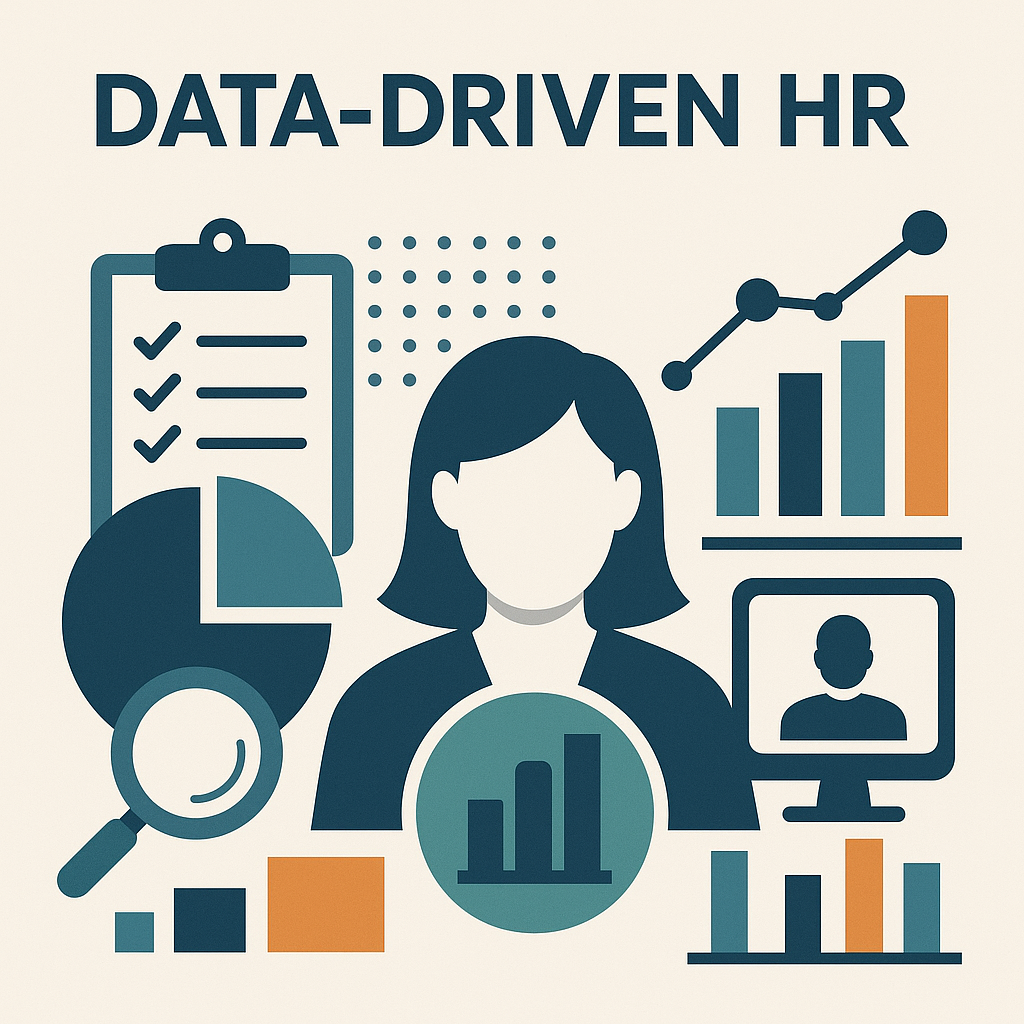
Increased Operational Efficiency
Data-driven HR can improve operational efficiency by up to 25%, reducing administrative burdens and freeing teams for strategic initiatives, highlighting the ROI of HR analytics.
Using tools such as ADP and Zenefits can make handling payroll, managing benefits, and organizing employee data easier, showcasing automation in HR.
For example, ADP handles payroll calculations and tax filings by itself, which saves time and reduces mistakes. Zenefits simplifies employee onboarding and benefits enrollment, reducing paperwork by up to 90%.
By using these platforms, companies can allocate resources to important HR projects, which improves employee involvement and retention.
Tracking metrics such as time saved on payroll processing and reduction in compliance issues can further illustrate the operational improvements achieved through automation, emphasizing cost reduction in HR.
Key Tools for Data-Driven HR and Workforce Analytics
There are many tools that help with data-focused HR, each with its own features that improve human resource management. If you’re interested in discovering top options available today.
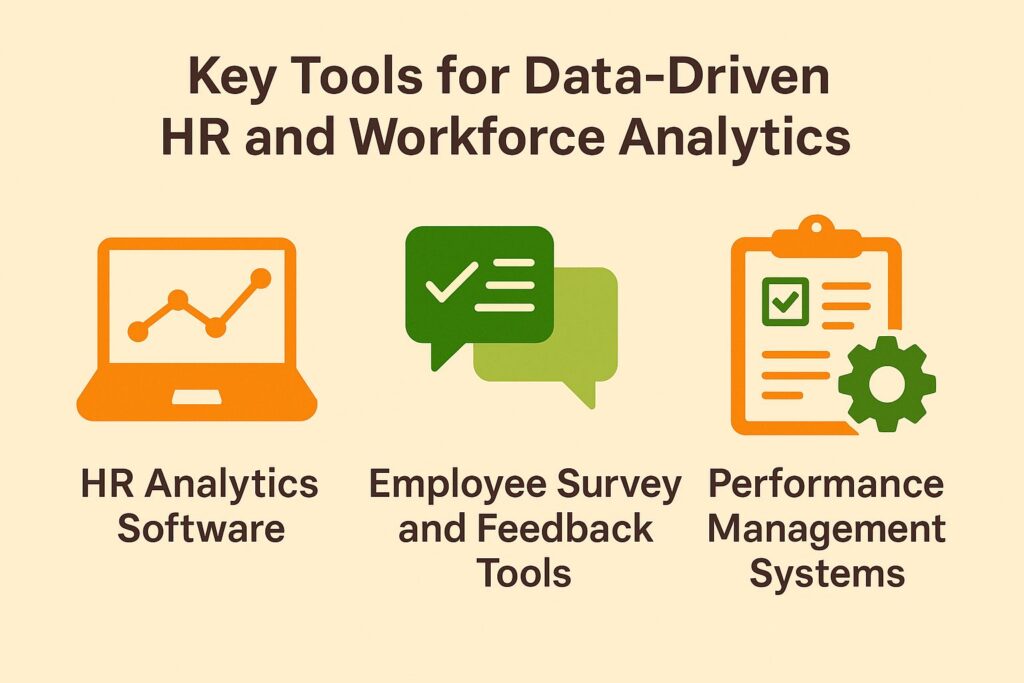
HR Analytics Software
Well-known HR analytics software options are Visier, with prices starting at $100 per month, and SAP SuccessFactors, which provides detailed information about workforce data and supports employee analytics.
Some other good choices are Workday, costing about $100 per month, known for its easy-to-use design and instant data analysis; and Oracle HCM Cloud, providing strong tools for around $90 per month, suitable for big companies.
For smaller companies, BambooHR, starting at $99/month, provides essential analytics without overwhelming users, aiding data-driven culture promotion.
These tools can help make better decisions: Visier has assisted companies like Coca-Cola in managing their employees more effectively, and Workday has made Adobe’s workforce planning more efficient.
Employee Surveys and Feedback Tools
Tools like SurveyMonkey (free-$25/mo) and Officevibe ($5/user/month) help organizations gather feedback from employees through surveys.
These tools provide customizable survey templates, enabling organizations to tailor questions according to their specific needs.
For instance, Officevibe offers pulse surveys that gauge employee morale regularly, while SurveyMonkey’s advanced analytics help identify trends over time.
Using this information helps make practical changes in the workplace and communication, which can lead to higher employee happiness and staying longer at the company, driving employee satisfaction.
Using these tools to start regular feedback discussions can involve employees more and create an environment where open communication and ongoing progress are encouraged.
Performance Management Systems
Performance management systems such as Lattice and 15Five make giving and receiving feedback better, with 75% of users saying their performance got better, enhancing performance appraisal processes.
These tools make it easy to give regular feedback and help employees develop through key features.
For example, Lattice provides feedback from all directions and goal tracking for about $9 per user per month. This helps improve team performance.
15Five focuses on weekly reviews and recognizing employees, which helps improve involvement, and costs around $7 per user each month.
By introducing these systems, companies can create a setting that encourages frequent discussions, which improves performance and emphasizes effective HR management.
Real-World Examples in HR Analytics Case Studies
Examples from actual companies show how they use data-focused HR strategies to meet particular business objectives.
Case Study: Company A’s Recruitment Success
Company A used data analytics tools to cut down hiring time from 45 days to 30 days, improving their recruitment process.
They used LinkedIn Talent Insights and HireVue to gather current data on candidates, making the interview process more organized.
They adopted predictive analytics to identify the most successful hiring criteria, allowing them to focus on candidates who aligned closely with previous high performers.
Company A reduced their hiring process duration and hired better employees, shown by a 20% rise in employee retention rates in the first year. This strategic approach turned their recruitment into a data-driven process.
Case Study: Company B’s Employee Retention Strategy
Through the implementation of predictive analytics and talent acquisition strategies, Company B improved employee retention rates by 20% over two years.
To do this, Company B used tools like Visier and Tableau to create visual displays of data and understand employee information. They analyzed turnover trends and employee feedback to identify risk factors, such as lack of career advancement and low engagement scores.
A focused plan was created to keep employees, emphasizing individual growth plans and mentorship programs. Regular pulse surveys were instituted to monitor employee sentiment, allowing for quick adjustments.
This method based on data improved employee satisfaction and helped build a positive workplace environment, strengthening loyalty and dedication.
Challenges in Implementing Data-Driven HR and Compliance in HR
Even with the advantages, organizations encounter difficulties in putting data-focused HR into practice, such as worries about data privacy and problems with combining systems. As mentioned in our article on Human Resources Tips for Managing Distributed Teams, addressing these challenges requires strategic planning and effective communication.
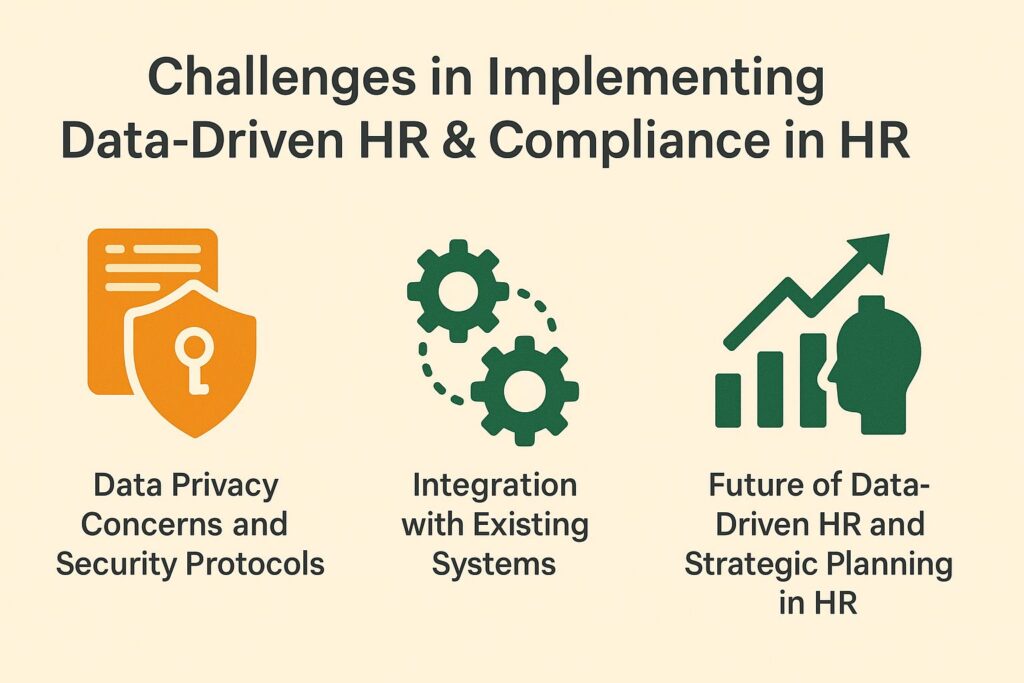
Data Privacy Concerns and Data Security Protocols
Data privacy concerns are paramount, with 70% of organizations citing GDPR compliance as a significant challenge in their HR data practices.
Non-compliance can result in hefty fines, legal action, and reputational damage. To mitigate these risks, organizations should implement key strategies:
- Regularly check how data is handled to make sure it follows the rules.
- Use encryption tools like VeraCrypt for sensitive information, ensuring effective data governance.
- Provide training for staff on data privacy practices.
Establish clear data retention policies to minimize unnecessary data storage, ensuring personal information is only held as long as needed. Following these steps improves compliance and builds trust with employees and clients.
Integration with Existing Systems
Integrating new data-driven HR tools with legacy systems, including cloud-based HR solutions and strategic HR management, often presents challenges, delaying the implementation process by an average of 6 months.
Typical challenges include ensuring data integration, enhancing data literacy in HR, teaching users, and dealing with change management resistance.
To address these issues and improve how an organization works, start by closely examining the existing systems. Use tools like Zapier and other HR software tools to connect different apps, letting you set up workflows between them without needing a lot of coding.
Offer detailed training and development for employees by using platforms like Udemy or LinkedIn Learning to aid in seamless transitions. Include team members from the start to reduce pushback and improve employee experience; their feedback is important for adjusting tools to fit the organization’s needs.
The Next Steps for Data-Based HR and Strategic Planning in HR
Companies will increasingly use predictive analytics, machine learning in HR, and advanced technologies for strategic planning in HR and planning their workforce.
By integrating machine learning algorithms, HR departments can analyze employee data and predict turnover rates, aiding in employee turnover analysis and enabling proactive talent retention strategies.
For example, tools like Visier can identify patterns in employee behavior and provide useful details, while ADP DataCloud allows quick access to information for informed decision-making.
Using AI-based hiring tools like Pymetrics can improve candidate evaluation by analyzing emotional characteristics, enhancing analytics-driven recruitment efficiency.
Using these technologies makes processes simpler, aids in job performance tracking, and helps create a more involved and productive team, enhancing organizational performance.
About the Author
Ellen Westbrook is a Stanford University graduate with a bachelor’s degree in human resources and psychology. She’s the owner of a successful HR and payroll outsourcing firm in Colorado and a contributing writer for HR Costs. With 17 years of experience, Ellen helps businesses reduce risk, manage HR more efficiently, and grow with confidence.

